PV column
consulting
2025/09/21
“UK Energy in brief 2025” by DESNZ
The Department for Energy Security & Net Zero (DENSZ) of the UK, an island nation like Japan, published the UK Energy in Brief 2025 on July 31, 2025.
(Contents)
- P5-7: Energy in the economy (contribution to the UK economy, employment trends, investment)
- P8-14: Overall energy (trends in fuels, energy consumption, import dependence, and ratios)
- P15-16: Climate change (greenhouse gas emissions, emissions by sector)
- P17: Security of supply
- P18-19: Coal (production, imports, and consumption from 1990 to 2024)
- P20-22: Petroleum (imports and exports, by segment, and automotive industry consumption from 1990 to 2024)
- P23-24: Oil and gas production (production and reserves from 1980 to 2024)
- P25-26: Natural gas (demand, production, and imports from 1990 to 2024)
- P27-29: Electricity (supply by energy source and power plant capacity from 1990 to 2024)
- P30-34: Renewables (trends in installed capacity, power generation, and supply share from 2010 to 2024)
- P35: Combined heat and power (trends in installed capacity of combined heat and power systems from 1994 to 2024)
- P36-39: Energy efficiency (trends in systems, insulation, and smart meter installations from 2000 to 2024)
- P40-42: Fuel (energy) poverty (number of households, income brackets, and cost-effectiveness from 2010 to 2024)
- P43-46: Prices (trends in price indexes, gasoline, diesel, and suppliers from 1990 to 2024)
- P47-50: Contacts, conversion factors and definitions, and references
This booklet brings together the latest statistics on energy production, consumption, prices and climate change in the UK. The figures are primarily based on the 2025 edition of the UK Energy Statistics Digest, published on 31 July 2025. Further details of this Digest and other Department for Energy Security and Net Zero (DESNZ) statistical publications on energy and climate change can be found on pages 49 and 50 of this booklet.
You can also find at:
https://www.gov.uk/government/organisations/department-for-energy-security-and-net-zero/about/statistics
In this column, we will introduce the contents of the reports on “The Energy Industry’s Contribution to the UK Economy” on pages 5-7 of the booklet, and “Renewable Energy” on pages 30-32 and 34.
Source: UK energy in brief 2025 https://www.gov.uk/government/statistics/uk-energy-in-brief-2025
Source (this booklet, PDF): https://assets.publishing.service.gov.uk/media/688890c3a11f859994409132/UK_Energy_in_Brief_2025.pdf
**********
THE ENERGY INDUSTRIES’ CONTRIBUTION TO THE UK ECONOMY IN 2024
- 2.4% of GVA (Gross Value Added).
- 158,400 people directly employed (5.6% of industrial employment) and more indirectly (e.g. in support of UK Continental Shelf production).
- 8.9% of total investment.
- 27.2% of industrial investment.
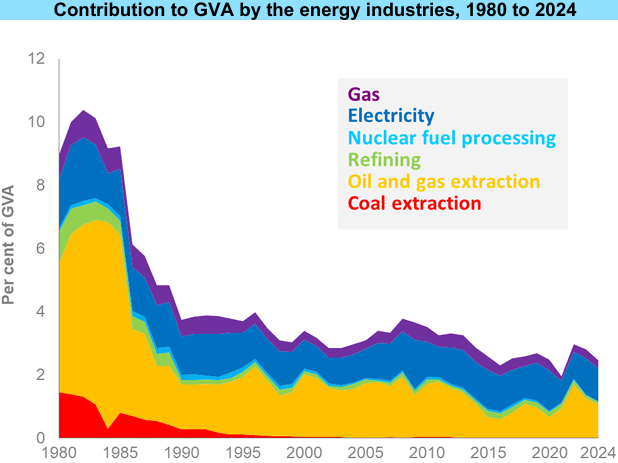
The contribution to the UK economy by the energy industries peaked in 1982 at 10.4%. In 2024, the contribution by the energy industries to the UK economy was 2.4% of GVA, down from 2.8% in 2023.
Despite its significant fall in 1986, oil and gas extraction has been the major energy contributor to the UK economy (with its value dependent both on production and the price of oil and gas). However, since 2014 electricity has become the major energy contributor. Of the energy total in 2024 electricity (including renewables) accounted for 43%, oil and gas extraction accounted for 41%, and gas accounted for 10%.
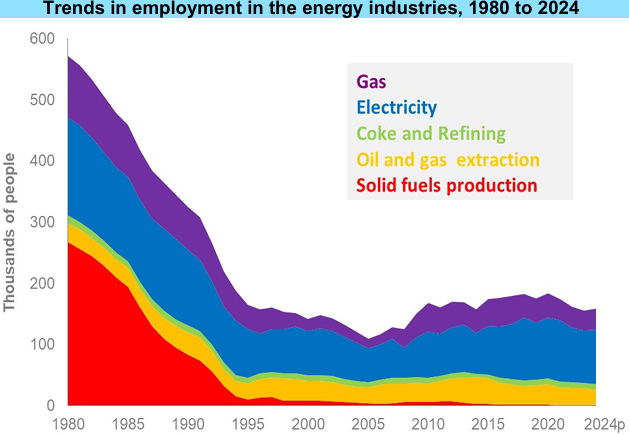
Employment in the energy production and supply industries fell rapidly throughout the 1980s and mid-1990s largely as a result of closures of coal mines. Between 1995 and mid 2000s employment declined more slowly but since 2006 it has increased gradually, driven largely by growth in the electricity and gas sectors. However, since 2020 employment in the energy industries has generally fallen back. In 2024 employment rose by 1.9% on the previous year to 158,400 which was 45% above the 2005 level and accounted for 5.6% of all industrial employment. Of the energy total in 2024 electricity (including renewables) accounted for 56%, gas accounted for 22% and oil and gas extraction accounted for 16%.
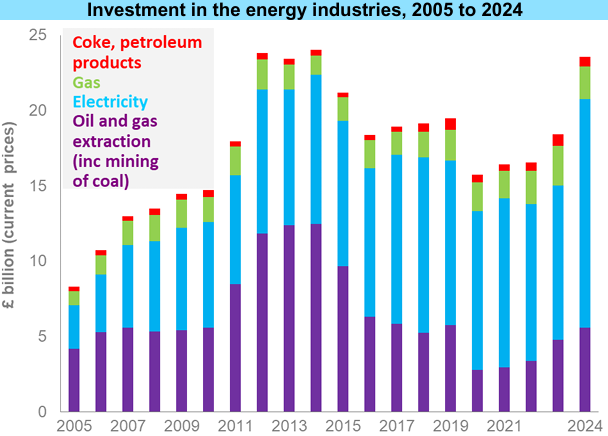
In 2024 investment in the energy industries at £23.6 billion (at current prices) was 28% higher than in 2023.
Of the total invested electricity contributed 64% (up 8.8 percentage points on 2023), oil and gas extraction (including a small proportion of less than 0.01% for coal extraction) contributed 24% (down 2.2 percentage points on 2023), gas contributed 9% (down 4.9 percentage points on 2023), with the remaining 3% in coke & refined petroleum products industries (down 1.6 percentage points on 2023).
**********
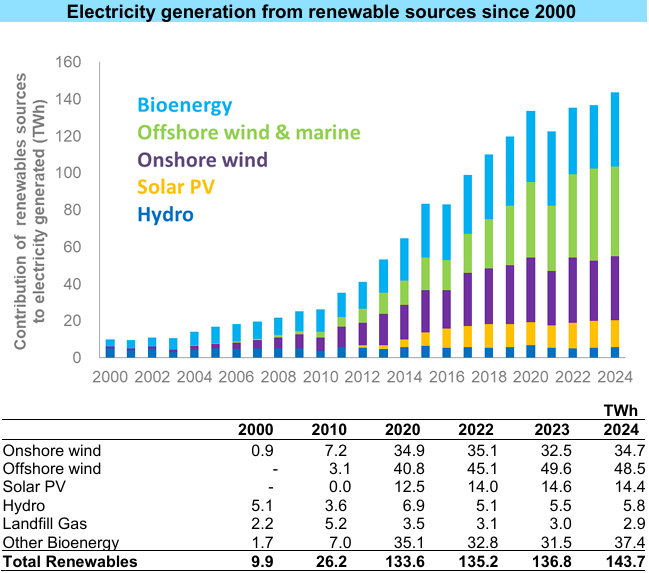
Electricity generated from renewable sources increased by 5.1% between 2023 and 2024 to a new record of 143.7 TWh, driven by new capacity and an increase in generation from plant biomass which had been dampened in 2022 and 2023 by reduced output at two major sites. Capacity grew by 7.3%, a larger increase than the 5.6% seen in 2023 and up on the growth rate seen in 2020 and 2021 where new capacity was hampered by COVID-19 restrictions. Renewable electricity accounted for 50.4% of electricity generated in the UK during 2024, the first time that renewables had accounted for over half of total generation and up by 3.9 percentage points on 2023 as a result of greater renewable generation and lower generation from other sources.
Onshore wind generation increased by 6.9 per cent in 2024, partly due to outages and curtailment in 2023, as well as increased capacity and slightly higher average wind speeds. Conversely, offshore wind generation was down on by 2.2 per cent 2023, hampered by planned maintenance, unplanned outages and curtailment. Solar PV generation fell 1.9 per cent due to lower average sunlight hours, 2024 was the least sunny year since our time series began in 2001. Plant biomass saw the biggest increase (27 per cent), while there were also records for anaerobic digestion and energy from waste.
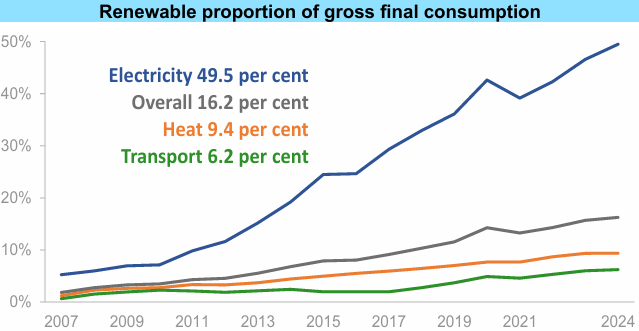
The Gross Final Consumption proportions in the chart reflect the proportion of renewable electricity and heat consumption before losses; the transport measure is on an actual consumption basis. The electricity measure excludes the use of electricity in transport which is allocated to that sector’s measure. Heat represents final consumption for fuels other than electricity but includes heat sold.
The proportion of electricity generation from renewables increased in 2024 to 49.5 per cent, in line with the actual generation measure, with renewable generation increasing by 5.1 per cent and total electricity consumption only marginally increasing (by less than 0.1 per cent). The proportion of heat from renewable sources has steadily increased from 1.2 per cent in 2007 to 9.4 per cent in 2024. This reflects the combination of both lower gas consumption and increasing renewable heat.
Given the dominance of renewable electricity in the overall renewable measure, the impact of higher renewable electricity supply in 2020 has pushed up the overall measure from 15.7 % in 2023 to 16.2% in 2024.
**********
The data shows that the installation of renewable energy as a power generation source in the UK is steadily increasing. Behind this data is likely the ongoing improvement of technical verification and analysis, as well as the installation of systems, when installing renewable energy.
The UK, with its shorter hours of sunshine, has less solar PV installed compared to Japan, but there is a huge difference between onshore and offshore wind power. Analyzing the causes of this difference may reveal areas for major improvement in Japan’s introduction of renewable energy.
Acknowledgements: We would like to thank the UK Department for Energy Security & Net Zero for reprinting this article.

